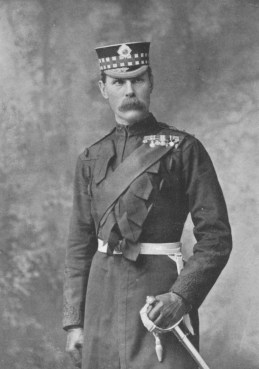
The 1st Division is an infantry division of the British Army that has been formed and disestablished numerous times since 1809 and is still currently active as the 1st Division. Lieutenant-General Arthur Wellesley raised the division for service in the Peninsular War, which was part of the Coalition Wars of the Napoleonic Wars. The division was disestablished in 1814 but reformed the following year for service in the War of the Seventh Coalition. It then fought at the Battle of Waterloo, where it repulsed numerous attacks, including the final attack of the day that was launched by the French Imperial Guard. Following the battle, the division marched into France and became part of the Army of Occupation before being disbanded a few years later.
Lindley is a small town situated on the banks of the Vals River in the eastern region of the Free State province of South Africa. It was named after an American missionary, Daniel Lindley, who was the first ordained minister to the Voortrekkers in Natal.

The Imperial Yeomanry was a volunteer mounted force of the British Army that mainly saw action during the Second Boer War. Created on 2 January 1900, the force was initially recruited from the middle classes and traditional yeomanry sources, but subsequent contingents were more significantly working class in their composition. The existing yeomanry regiments contributed only a small proportion of the total Imperial Yeomanry establishment. In Ireland 120 men were recruited in February 1900. It was officially disbanded in 1908, with individual Yeomanry regiments incorporated into the new Territorial Force.

The Battle of Modder River was an engagement in the Boer War, fought at Modder River, on 28 November 1899. A British column under Lord Methuen, that was attempting to relieve the besieged town of Kimberley, forced Boers under General Piet Cronjé to retreat to Magersfontein, but suffered heavy casualties altogether.
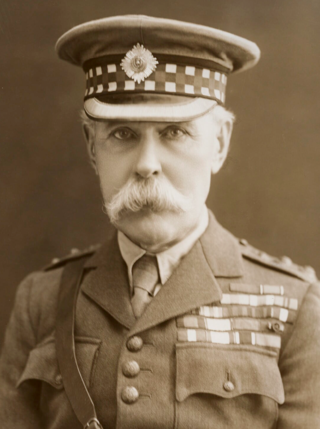
Field Marshal Paul Sanford Methuen, 3rd Baron Methuen,, was a British Army officer. He served in the Third Anglo-Ashanti War in 1873 and then in the expedition of Sir Charles Warren to Bechuanaland in the mid-1880s. He took a prominent role as General Officer Commanding the 1st Division in the Second Boer War. He suffered a serious defeat at the Battle of Magersfontein, during which he failed to carry out adequate reconnaissance and accordingly his artillery bombarded the wrong place leading to the Highland Brigade taking heavy casualties. He was later captured by the Boers at Tweebosch. After the war, he became General Officer Commanding-in-Chief in South Africa in 1908, Governor and Commander-in-Chief of Natal in 1910 and then Governor and Commander-in-Chief of Malta in 1915.
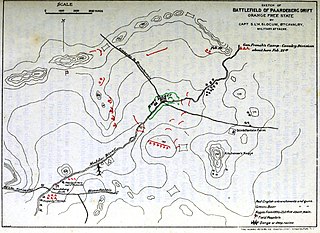
The Battle of Paardeberg or Perdeberg was a major battle during the Second Anglo-Boer War. It was fought near Paardeberg Drift on the banks of the Modder River in the Orange Free State near Kimberley.

The Battle of Magersfontein was fought on 11 December 1899, at Magersfontein, near Kimberley, South Africa, on the borders of the Cape Colony and the independent republic of the Orange Free State. British forces under Lieutenant General Lord Methuen were advancing north along the railway line from the Cape to relieve the siege of Kimberley, but their path was blocked at Magersfontein by a Boer force that was entrenched in the surrounding hills. The British had already fought a series of battles with the Boers, most recently at Modder River, where the advance was temporarily halted.

The Battle of Berg-en-dal took place in South Africa during the Second Anglo-Boer War.
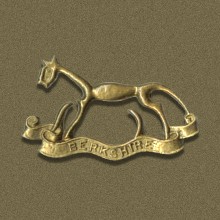
The Berkshire Yeomanry was a part time regiment of the British Army formed in 1794 to counter the threat of invasion during the French Revolutionary Wars. It was the Royal County of Berkshire's senior volunteer unit with over 200 years of voluntary military service. After taking part in the Second Boer War, it saw action as mounted troops in the First World War and as artillery in the Second World War. Its lineage is maintained by 94 Signal Squadron, part of 39 (Skinners) Signal Regiment. The Headquarters of the Squadron is based in Windsor, Berkshire. The Berkshire Yeomanry had a number of battle honours won from Europe to the Far East and Private Frederick Potts was awarded a Victoria Cross for service during the Gallipoli Campaign.
The Battle of Rooiwal was an engagement of the Second Boer War. It took place on 11 April 1902 and resulted in a victory by a British force commanded by Colonel Robert Kekewich over a Boer commando led by Generals Ferdinandus Jacobus Potgieter and Jan Kemp.
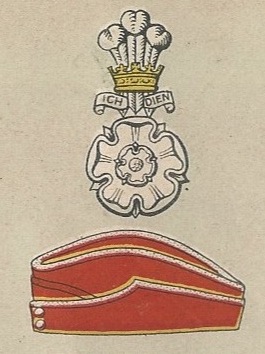
The Yorkshire Hussars was an auxiliary unit of the British Army formed in 1794. The regiment was formed as volunteer cavalry (Yeomanry) in 1794 during the French Revolutionary Wars and served in the Second Boer War and the First World War. It was converted to an armoured role during the Second World War. In 1956, it merged with two other Yorkshire yeomanry regiments to form the Queen's Own Yorkshire Yeomanry. Its lineage is continued today by the Queen's Own Yeomanry.

The Queen's Own Yorkshire Dragoons was a yeomanry regiment of the British Army in existence from 1794 to 1956. It was formed as a volunteer cavalry force in 1794 during the French Revolutionary Wars. Its volunteer companies played an active role with the Imperial Yeomanry in the Second Boer War, but opportunities for mounted action were much more restricted during the First World War and it was temporarily converted into a cycle unit. It remained a cavalry regiment throughout the interwar years, and was the last horsed unit of the British Army to see action, in the Syria–Lebanon Campaign of 1941, finally mechanising the following year. It served as motorised infantry in the North African and Italian campaigns of the Second World War. In 1956, it merged with the Yorkshire Hussars and the East Riding of Yorkshire Yeomanry to form the Queen's Own Yorkshire Yeomanry. Its lineage is continued today by A Squadron, the Queen's Own Yeomanry.
Hartbeesfontein, officially Lethabong, is a settlement near Klerksdorp, in the North West province of South Africa. It is situated at the intersection of the R503 and R507 routes.
The 19th Battalion was a unit of the Imperial Yeomanry raised by George Paget as auxiliaries to the British Army during the Second Boer War. The men were mainly upper middle class and recruited from the gentlemen's clubs of London. The unit saw action at Faber's Put, Elands River, Lichtenburg, and numerous engagements on the lines of communication. The battalion was disbanded after the war.
21st Brigade was an infantry formation of the British Army first organised in the Second Boer War, when it took part in Ian Hamilton's March from Bloemfontein to Pretoria. Reformed in World War I it served under the command of first 7th Division and then 30th Division, fighting in most of the major battles on the Western Front from the First Battle of Ypres to the Armistice. It was briefly re-raised in the Sudan early in World War II before being transferred to the Indian Army.
Herbert Melville Guest was an author, newspaper owner and politician of the Transvaal. He acquired the Klerksdorp Mining Record in 1889. He wrote several books on the Second Boer War in the area of Klerksdorp. In 1903 he became one of the first city council members and was mayor from 1910 to 1911. One of his sons was Ernest Lucas Guest, the prominent government minister of Southern Rhodesia.

The Battle of Boshof was a battle fought during the Second Boer War on 5 April 1900 between British forces and mostly French volunteers of the Boer army.

42nd (Hertfordshire) Company was a unit of the Imperial Yeomanry formed to supplement the British Army in the Second Boer War. Raised by the part-time Hertfordshire Yeomanry and largely drawn from its ranks, the company was engaged at the Rhenoster River, in the Brandwater Basin, and in various small engagements round Krugersdorp. It was replaced by a new 42nd Company in 1901.
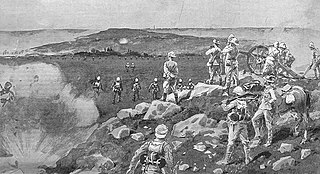
The Battle of Doornkop was a battle fought during Lord Roberts' advance on Johannesburg in May and June 1900.
The 9th (Welsh) Battalion, Imperial Yeomanry was a unit of the British Imperial Yeomanry (IY) raised for service in the Second Boer War. Equipped as Mounted infantry, the battalion served in South Africa from April 1900 until the end of the war. Its companies took part in numerous anti-guerrilla 'drives' with mobile columns that eventually brought the war to an end.












